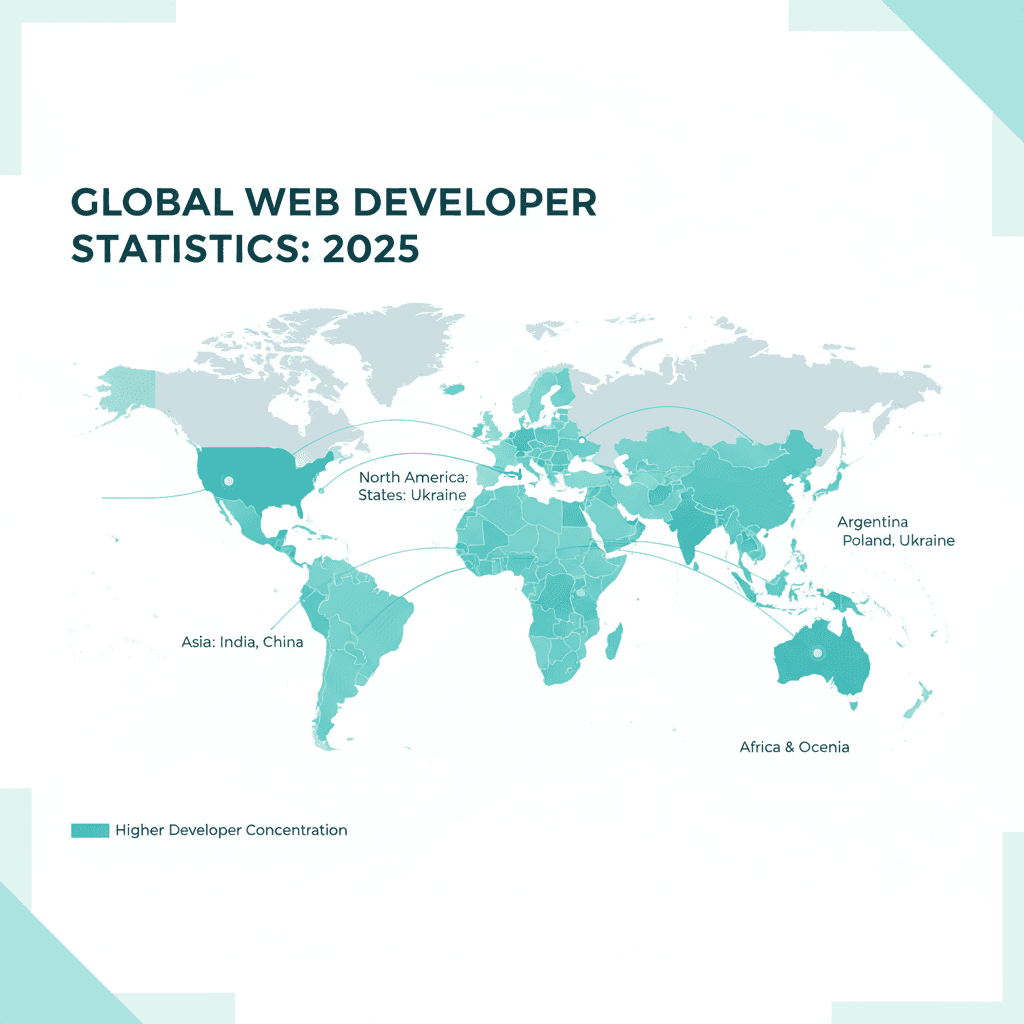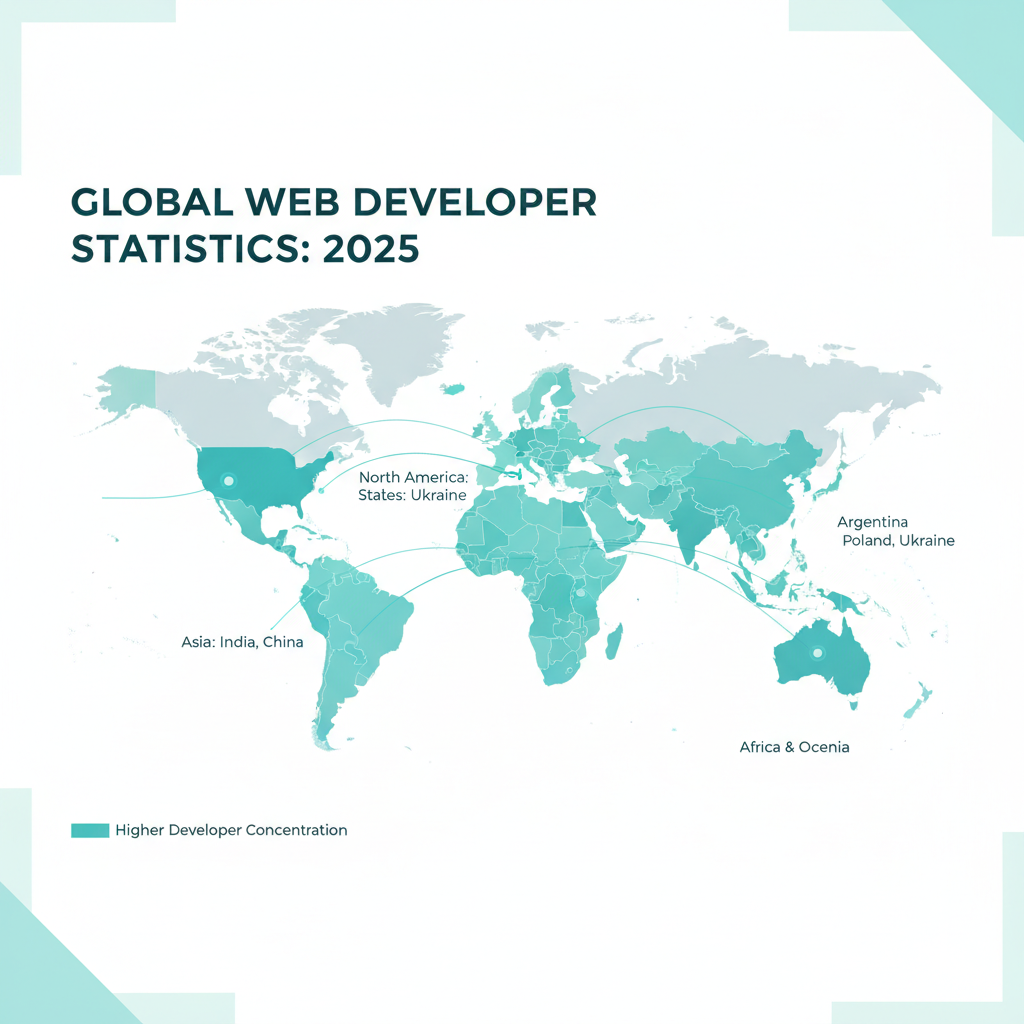-
The number of web developers worldwide has reached 30 million in 2025, showcasing the immense demand for tech talent.
-
From North America to Africa, web development is a booming field with major hubs emerging across the globe.
How Many Web Developers Are There in 2025?

Every day, billions of people interact with websites. Where is it shopping online, booking flights, reading news, or chatting with friends.
But have you ever wondered -
Who builds and maintains these digital spaces?
Behind every seamless user experience are web developers: the architects of the digital world.
The number of web developers is growing rapidly, with new technologies, global demand, and accessible learning opportunities attracting millions worldwide.
In this article, we’ll explore how many web developers exist today, where they’re located, the roles they play, emerging trends, and how you can step into this ever-evolving career.
Global Web Developer Statistics: How Many Are There?
As of 2025, industry estimates suggest there are approximately 30 million web developers worldwide, spanning front-end, back-end, and full-stack roles.
Male developers still represent the majority (~78%), but female participation is steadily increasing, now at around 22%.
Regional Distribution of Web Developers
- Asia: India, China, and other tech hubs dominate with millions of skilled developers.
- North America: The United States leads, with Silicon Valley and other cities contributing heavily.
- Europe: Eastern Europe, particularly Poland and Ukraine, continues to grow as a hotspot for tech talent.
- Latin America: Countries like Argentina and Colombia are expanding rapidly through government-backed tech programs.
- Africa & Oceania: Emerging markets in Nigeria, Kenya, and Australia are fueling innovation and development talent.

Types of Web Developers
Web development roles have diversified. Each specialization is critical for building functional, secure, and engaging digital experiences.
1. Front-End Developers
- Focus on user interfaces (UI), visuals, and website interaction.
- Work with HTML, CSS, JavaScript, and frameworks like React, Vue.js, or Angular.
Impact: They shape the first impression users have, creating interactive and visually appealing digital environments.
2. Back-End Developers
- Manage server-side logic, databases, and infrastructure.
- Use languages like PHP, Python, Java, Ruby, and frameworks such as Django, Node.js, Express.js, or Ruby on Rails.
Impact: They ensure websites are fast, secure, and scalable, working behind the scenes to deliver seamless functionality.
3. Full-Stack Developers
- Combine front-end and back-end expertise.
- Handle projects from start to finish, integrating server-side logic with UI seamlessly.
- Highly sought-after due to versatility in handling complete web solutions.
4. DevOps Engineers
- Bridge development and operations, focusing on deployment, scalability, and automation.
- Use tools like Docker, Jenkins, and CI/CD pipelines.
Impact: Ensure reliable, efficient, and continuous website performance.
Specialization Breakdown
According to combined Stack Overflow surveys (2023–2025):
- Full-stack developers: 34%
- Back-end developers: 18%
- Front-end developers: 7%
- Other roles include DevOps engineers and UX/UI specialists.
Factors Driving the Growth of Web Developers
1. Technological Advancements
- Platforms like WordPress, Wix, and Webflow make building websites accessible even without coding knowledge.
- Advanced frameworks like React, Angular, and Vue accelerate professional development.
- AI-assisted development tools, low-code/no-code platforms, and automation are reshaping how developers work.
2. Economic Factors
- Tech booms, startups, and digitalization have made web development a lucrative and high-demand career.
- Businesses require an online presence, increasing the global demand for skilled developers.
3. Educational Opportunities
- Online courses on Udemy, Coursera, and freeCodeCamp allow developers to learn anywhere.
- Coding boot camps provide intensive, practical skill-building programs.
Universities are updating programs to focus on modern web technologies, ensuring graduates stay competitive.
Emerging Trends in Web Development (2025 Edition)
- AI-Powered Development: Tools like GitHub Copilot assist developers in writing code faster.
- Progressive Web Apps (PWAs): Provide app-like experiences on the web.
- Serverless Architecture: Cloud-based back-end reduces infrastructure management.
- Jamstack Development: Enhances performance, security, and scalability.
- Focus on Accessibility and UX: Web inclusivity and improved user experience are now priorities globally.
Career Guidance: Becoming a Web Developer
- Choose Your Path: Front-end, back-end, full-stack, or DevOps.
- Learn the Core Languages: HTML, CSS, JavaScript, Python, or Ruby.
- Build Real Projects: Portfolio websites, apps, and open-source contributions.
- Stay Updated: Follow latest frameworks, AI tools, and web standards.
- Network & Collaborate: Join communities like GitHub, Stack Overflow, or local tech groups.
Conclusion: The Indispensable Web Developer
Web developers are the backbone of the digital world.
From front-end developers creating stunning interfaces, back-end experts ensuring seamless functionality, to full-stack and DevOps professionals bridging both worlds, the industry is dynamic and rewarding.
With 30 million developers worldwide and growing demand fueled by technology, education, and economic factors, web development is a career of immense potential.
CTA:
Whether you’re looking to hire web talent or start your own journey, now is the perfect time to engage with the digital revolution.
Explore resources, learn, and become part of this global community shaping the future online.

About the Author
Hey, I'm MD SHAMIM HOSSEN, a Content Writer with a passion for tech, strategy, and clean storytelling. I turn AI and app development into content that resonates and drives real results. When I'm not writing, you'll find me exploring the latest SEO tools, researching, or traveling.
Trendingblogs
Get the best of our content straight to your inbox!
By submitting, you agree to our privacy policy.








